Many thanks to SWLing Post contributor, ShortwaveGuy, who shares the following guest post originally published on his blog, Shortwave.me:
Tried And True. . .Revisiting Older Receivers – Realistic DX-440
by ShortwaveGuy
Anyone who knows me, knows I am a fan of the “latest and greatest” when it comes to shortwave receivers. Like most of us involved in the hobby, I am always on the lookout for what newer technology has to offer me in order to pursue my quest of either capturing that elusive DX signal, or whatever will bring my favorites in the clearest. As a result, over the past few years, I have collected an assortment of receivers, each one serving a different purpose. My wife can not only attest to this, but can also relate to this phenomenon, as someone who has far more shoes than she will ever have time or fortune to wear! That’s how I am with my radios!
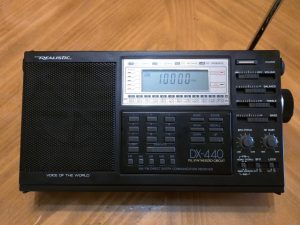 The other day, however, while listening to some of my favorite stations on what is arguably my best current portable receiver, the Tecsun PL-660, I got to thinking about some of my other receivers, in particular, my Realistic DX-440. I have had this receiver for as long as I can remember and I can remember back a long time! Around the time it came out, the radio most of us had our eyes on was the venerable Sony ICF-2010. Like a lot of people, however, I had no means of purchasing a receiver as expensive as it was at the time. I hoped that somehow, I would be able to afford one and one day, I did buy one, but that’s a story for another time, however.
The other day, however, while listening to some of my favorite stations on what is arguably my best current portable receiver, the Tecsun PL-660, I got to thinking about some of my other receivers, in particular, my Realistic DX-440. I have had this receiver for as long as I can remember and I can remember back a long time! Around the time it came out, the radio most of us had our eyes on was the venerable Sony ICF-2010. Like a lot of people, however, I had no means of purchasing a receiver as expensive as it was at the time. I hoped that somehow, I would be able to afford one and one day, I did buy one, but that’s a story for another time, however.
In the mean time, I can remember perusing the latest Radio Shack catalog, something I did as often as they came out when I saw it. . .a radio with all kinds of wonderful buttons and knobs! The top of the page screamed out at me: “CATCH THE ACTION ON MULTIBAND PORTABLES”. It was the Realistic DX-440! Here is a picture of the ad as it appeared:
Once I saw it, I knew I must have it! While the MSRP on the Sony ICF-2010 was $449, this gem could be had for less than $200! All my previous radios had analog tuning so the prospect of getting a radio with a digital display was quite appealing to me! Try as I may to convince my parents to get me just this one Christmas gift instead of several, it didn’t happen. . . .at that time. But fast forward several years later. . .
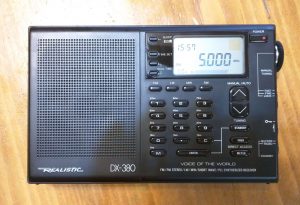 I finally got my digital receiver in the form of the Realistic DX-380 from my parents one Christmas. I worked that thing for years, and was mostly happy with it. It didn’t have SSB, which I had begun to understand by that time. I had pulled in a lot of great stations such as HCJB, BBC, VOA, Radio Havana Cuba and many others. However, because it didn’t have SSB, there were several occasions where I would happen upon ham radio operators who were talking back and forth, utility stations or even pirate stations. I could never be for sure, though, because my unit was not equipped to decode those signals. I knew that it was time to finally remedy that.
I finally got my digital receiver in the form of the Realistic DX-380 from my parents one Christmas. I worked that thing for years, and was mostly happy with it. It didn’t have SSB, which I had begun to understand by that time. I had pulled in a lot of great stations such as HCJB, BBC, VOA, Radio Havana Cuba and many others. However, because it didn’t have SSB, there were several occasions where I would happen upon ham radio operators who were talking back and forth, utility stations or even pirate stations. I could never be for sure, though, because my unit was not equipped to decode those signals. I knew that it was time to finally remedy that.
I purchased a few other radios that would do SSB and most of them worked reasonably well. At one point, I had even managed to procure the much-celebrated ICF-2010, which I loved dearly until it died a slow and unfortunate death that those with the know-how told me was beyond repair. But always, in the back of my mind, I wondered about that near-mystical Realistic DX-440. . .dreaming about what might have been.
I contented myself with the radios I had, still enjoying this wonderful hobby that I have participated in for so many years. I was, with the exception of the now-departed 2010, generally happy with the receivers that I had. I wasn’t looking for a new radio, but one night, mostly out of boredom, I wandered on to eBay and did a search for shortwave radios. I looked at tabletops and ultralights, primarily as I really had neither and had plenty or portables. About two pages in, I saw the Realistic DX-440. It only took about 10 minutes before I decided that this one must be mine. I placed my bid and waited patiently. . .only to lose the auction. “Oh, well”, I thought. If I saw another one, I might try again. . .or maybe not.
Well, the next day, I did a search and found one. This one looked in fantastic shape and had no bids. There was a “Buy It Now” price, but I wanted to get this for as inexpensively as I possibly could. The auction ended in 5 hours. I chose not to bid, not wanting to draw attention to it. I set an alarm on my watch and came back in an hour. . .still no bids. I set another alarm. With only 3 hours left, I began to get excited. Another hour went by and another alarm had been set. 2 hours to go. Any bidders, yet? No! Could this really happen? Maybe!
When I got down to the final hour of the auction, I didn’t bother to set an alarm. Like a watched pot that never boils, I stared at the web page, refreshing it every couple of minutes. With every refresh, it began to seem as if this might come to a happy conclusion. 10 minutes left. . .no bids. 5 minutes left. . .still no bids. I waited until 30 seconds before the end of the auction and placed the minimum bid.
Tick. Tock. Tick. Tock. Tick. Tock.
Auction over.
I HAD WON!
A dream over 20+ years in the making had finally happened! I quickly paid for the radio and then purchased the appropriate “wall-wart” adapter to make sure I had it ready for when the radio arrived. It said it would be 7-10 days for delivery, but it was at my house in 3!
I opened the box and carefully wrapped in old newspaper, was the radio that I had been pining for since my early teens. I quickly checked it out to make sure it was in good condition and was pleased to find it was. My heart sank a little bit when I opened the battery compartment to find 2 AA cells left in for the last 5 years that were supposed to power the clock and the memory functions. Fortunately, they had not exploded and I quickly removed them and replaced the unit with a fresh round of batteries. The only flaw I was able to find was that it seemed that the previous owner had lost the screw on tip of the internal whip antenna and had placed a plastic cap on the end in its place. It didn’t look out of place and was very secure, so I shrugged it off. Now for the moment of truth: I powered the radio on and it worked! I checked all the bands and was able to receive quite well on all of them except LW (which is to be expected, given my geographic location and the lack of stations on the longwave band, in general). All the knobs were there and in place and there were no dirty switches or tuning pots to deal with. I had snagged myself a honey of a bargain!
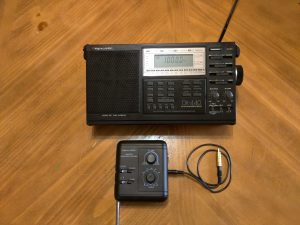 Now it was time to use this thing for what I bought it for: to listen to shortwave radio! I usually use a 100 foot longwire antenna when I listen to shortwave, and this time would be no exception. However, I was anxious to pair the DX-440 with the Realistic 20-280 amplified antenna that I had picked up years ago at an auction. I had used it with other radios, but never in conjunction with a longwire antenna. I was ready to change that. I wanted to use the preselector function of the amplified antenna as well as the actual amplifier in order to maximize my ability to pull in distant stations. When the radio was first manufactured, there were a lot more stations on the air to listen to and less of a need to do much more than throw 20 feet of wire up in a tree. Obviously, with many of the powerhouse shortwave stations having gone the way of the internet, I knew that my plan to couple the longwire with the amplified antenna had the potential to pay big dividends. I took a look at the back of the radio, where the external antenna jack was and I was surprised to find not the 1/8? jack I was accustomed to, but in its place was an RCA phono plug. The amplified antenna had an RCA plug on its side, as well, but it wasn’t to connect to a radio, it was for connecting to an antenna. The amplified antenna had the 1/8? plug and accompanying cable that was used to connect to the external antenna jack of nearly every modern portable radio. To be honest, I wasn’t completely sure how I was going to go about handling this issue. I thought about using alligator clips, but wasn’t sure how to integrate this into my coupling scheme.
Now it was time to use this thing for what I bought it for: to listen to shortwave radio! I usually use a 100 foot longwire antenna when I listen to shortwave, and this time would be no exception. However, I was anxious to pair the DX-440 with the Realistic 20-280 amplified antenna that I had picked up years ago at an auction. I had used it with other radios, but never in conjunction with a longwire antenna. I was ready to change that. I wanted to use the preselector function of the amplified antenna as well as the actual amplifier in order to maximize my ability to pull in distant stations. When the radio was first manufactured, there were a lot more stations on the air to listen to and less of a need to do much more than throw 20 feet of wire up in a tree. Obviously, with many of the powerhouse shortwave stations having gone the way of the internet, I knew that my plan to couple the longwire with the amplified antenna had the potential to pay big dividends. I took a look at the back of the radio, where the external antenna jack was and I was surprised to find not the 1/8? jack I was accustomed to, but in its place was an RCA phono plug. The amplified antenna had an RCA plug on its side, as well, but it wasn’t to connect to a radio, it was for connecting to an antenna. The amplified antenna had the 1/8? plug and accompanying cable that was used to connect to the external antenna jack of nearly every modern portable radio. To be honest, I wasn’t completely sure how I was going to go about handling this issue. I thought about using alligator clips, but wasn’t sure how to integrate this into my coupling scheme. 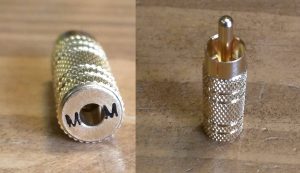 I pondered over this for all of about 3 minutes and than quickly got into my car and headed to my local Radio Shack. I told them I was looking for a 1/8-inch phone plug-to-phono jack and they were quick to accommodate me. They gave me the adapter you see pictured here (Catalog #: 2740871). It would handle either stereo or mono input of a 1/8-inch plug and as a bonus, it says “MOM” on the end, if you are willing to use the input hole as the letter “O”.
I pondered over this for all of about 3 minutes and than quickly got into my car and headed to my local Radio Shack. I told them I was looking for a 1/8-inch phone plug-to-phono jack and they were quick to accommodate me. They gave me the adapter you see pictured here (Catalog #: 2740871). It would handle either stereo or mono input of a 1/8-inch plug and as a bonus, it says “MOM” on the end, if you are willing to use the input hole as the letter “O”.
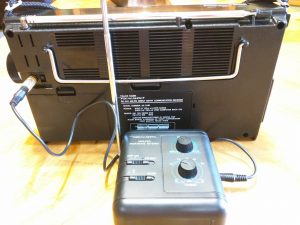 I got it home and quickly got it hooked up. As I expected, the “MOM” adapter was a perfect fit. I made sure I had fresh batteries in the amplified antenna, though it would accept an AC adapter if I wanted. I chose to run it on battery, so as to reduce any possible introduction of noise to the signal. And then, I powered on both the amplified antenna and the DX-440. . .the moment of truth had arrived! I tuned to WWV on 15 mHz, which I use as a baseline for most test I conduct on my radios during the time of day I was listening. I must tell you, I was NOT disappointed in what I heard. It was a rather cloudy day weather-wise and I was concerned about a middling solar flux. I needn’t have been worried at all. The signal was robust and clear as the familiar sound came booming in from Fort Collins, Colorado! Not only was the signal strong, but using the separate bass and treble controls and the wide selection on filters, it was actually rather pleasant listening, not fatiguing at all. I pulled up my trusty shortwave schedules app on my phone and began searching for things to listen to.
I got it home and quickly got it hooked up. As I expected, the “MOM” adapter was a perfect fit. I made sure I had fresh batteries in the amplified antenna, though it would accept an AC adapter if I wanted. I chose to run it on battery, so as to reduce any possible introduction of noise to the signal. And then, I powered on both the amplified antenna and the DX-440. . .the moment of truth had arrived! I tuned to WWV on 15 mHz, which I use as a baseline for most test I conduct on my radios during the time of day I was listening. I must tell you, I was NOT disappointed in what I heard. It was a rather cloudy day weather-wise and I was concerned about a middling solar flux. I needn’t have been worried at all. The signal was robust and clear as the familiar sound came booming in from Fort Collins, Colorado! Not only was the signal strong, but using the separate bass and treble controls and the wide selection on filters, it was actually rather pleasant listening, not fatiguing at all. I pulled up my trusty shortwave schedules app on my phone and began searching for things to listen to.
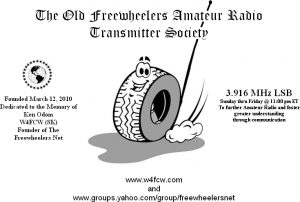 I heard domestic broadcasters like WRMI and WBCQ with no issues and managed to catch BBC to West Africa, as well! I listened to quite a bit that night and into the morning hours, checking out not only broadcast shortwave, but utilizing the BFO to listen to ham bands, particularly my favorite, the Freewheelers Net on 3.916 mHz, LSB. The BFO was easy to operate and the addition of the Realistic amplified antenna helped to bring in signals with great gusto. As with any amplified antenna that is not a loop, this one amplified not only the signal, but the noise as well. That said, the propagation deities were kind to me and I enjoyed a long night of listening.
I heard domestic broadcasters like WRMI and WBCQ with no issues and managed to catch BBC to West Africa, as well! I listened to quite a bit that night and into the morning hours, checking out not only broadcast shortwave, but utilizing the BFO to listen to ham bands, particularly my favorite, the Freewheelers Net on 3.916 mHz, LSB. The BFO was easy to operate and the addition of the Realistic amplified antenna helped to bring in signals with great gusto. As with any amplified antenna that is not a loop, this one amplified not only the signal, but the noise as well. That said, the propagation deities were kind to me and I enjoyed a long night of listening.
I have since given my DX-440 a place next to my bedside and have enjoyed listening to whatever I could find to listen to most nights. While a radio like the Tecsun PL-660 offers newer technology and the addition of an excellent synchronous detector, the DX-440 holds its own against the newer technology. At the end of the day, it’s still a portable and while most portables pale in comparison to tabletop rigs, this one is rather excellent with what it has offer versus its price point. The build quality is solid and ergonomically it is a pleasure to operate. If I had any critiques at all, I would have made the BFO and the RF Gain knobs a bit bigger, but now I am truly splitting hairs. I can see why contemporaneous editions of the Passport To Worldband Radio listed this as an Editors’ Choice radio back in the day.
I wanted one from the day I saw it those many years ago, and I can say unequivocally, that it was worth the wait!
–ShortwaveGuy
Thank so much for writing about the DX-440–that radio has a special place in my heart. The ‘440 was my first digital shortwave receiver–it revolutionized my shortwave listening.
As I’ve mentioned before, I also travelled with the Radio Shack DX-440 while studying French and living in Grenoble, France. The DX-440 delivered my daily dose of the Voice of America (the only English language news I allowed myself to listen to at the time). Since the VOA broadcast often coincided with meal time at the Université Stendhal cafeteria, I left my voice-activated Micro Cassette recorder in front of the DX-440 which was, in turn, set to turn on one minute prior to the VOA broadcast. It was an amazingly reliable arrangement.
I’d better not wax too nostalgic, though, else I’ll start searching eBay for a 440 just like you did! Hang onto that DX-440–I wish I would have never given mine away!

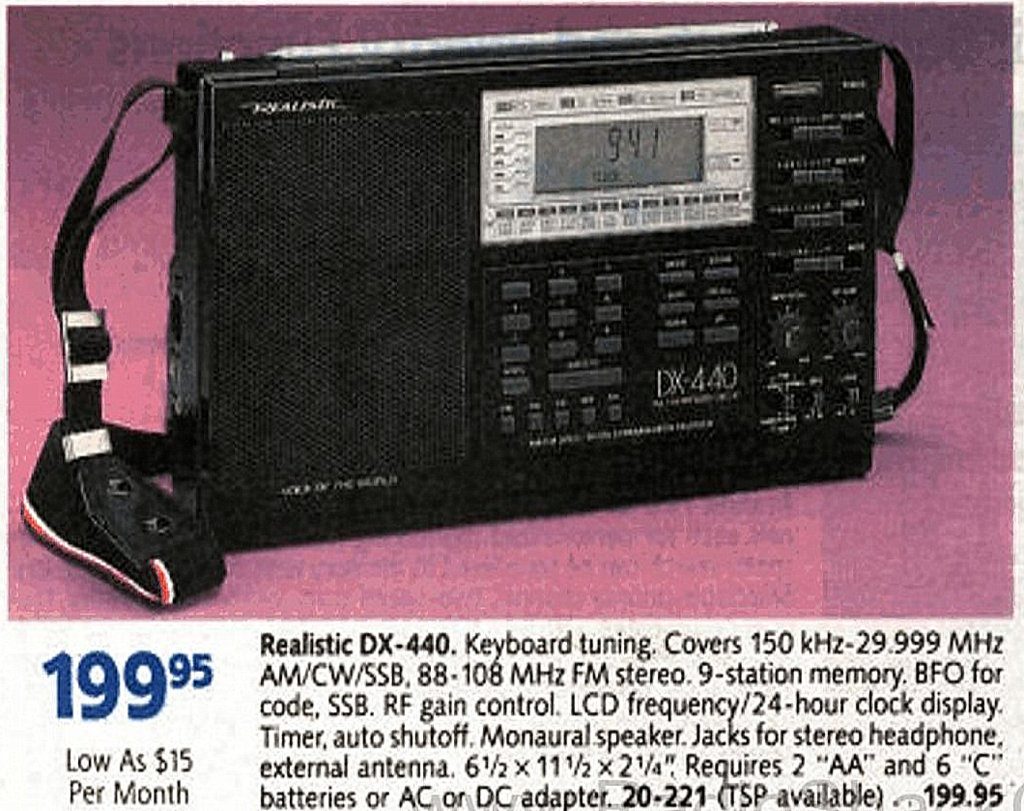
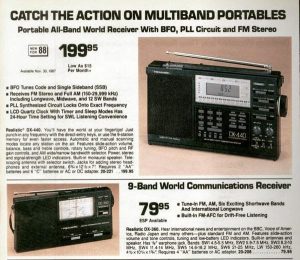
I got mine in December ’91. It’s still by my side and working fine!
(I eventually changed to a regulated power supply, which doesn’t interfere with reception.)
I must say that radio is built like a tank and works better than some of the radios on market today. Speaker is nice size and sounds decent. The only flaw I see in this radio is the batteries. It’s an ugly duckling radio that most anyone would want in their ham swl shack. I own a few of them and if I see another that looks good I would purchase it in a heartbeat if the price is right The performance and sensitivity is still one of the better radios
I got My DX 440 on sale for 139.99 in Newburyport Mass probably in 89 or 90 and used it as an alarm clock for almost 15 years until it stopped working in 2004. I would listen to Art Bell, WWCR and more than I can remember and packed it away somewhere with the hopes of getting it fixed someday .
i have been a ham operator for over 40 years and first saw the dx-440 shortly after they came out. a man i worked with bought one, it was a very strong receiver. all these years later i have wanted one and decided it was time. i ordered one from ebay and waiting for tomorrow when it is to arrive. seldom have i ever been so impressed with a radio such as this one. i have a grundig yb-400 and while a good receiver it is no where as friendly if you just want to tune around as the dx-440. i would recommend this radio to any one wanting a friend and strong receiver.
Omg I did the same thing last 3 weeks. I purchased a kenwood r2000 yaesu frg 7 and sangean ats 803. Such classic radios I kept dreaming about since I was teenager looking at catalogs popular communication. This might sound crazy I think the yaseiu frg can compete against the kenwood t5000. The yaseu frg is very loud and I now have 2 because of the toughness. Like you I have the portables but these receivers just hold a special place in your heart .
I need help and advice on my DX-440,of which for me is a Sangean ATS-803A,but the actural name on it is SAISHO SW 5000. I bought it at a radio junk sale and it acturly works very well,supprisingly.This one was made in Taiwan,hence the name “Saisho”,but yes Its the same as the DX-440 & Sangean ATS-803A.Reason for my asking for help & advice is that the front metal panel,that houses the buttons ,of which looks like Aluminum is very badly pitted or corroded.So much that it spoils the look of it front on.I have tried lightly sanding it but I can see the deep pits right into the metal.Maybe a vinyl plastic transfere thats printed will stick over it.These old radios are hard to find now and this one is worth keeping,because it performs so well.So any advice on what I should do would be very wellcome.Thanks.
James, if you could send me a photo, I’ll make a post about this. It’ll get more visibility. I think a good photo will help readers give you suggestions!
Best,
Thomas
For that guy with the DX-440 that won’t power up on batteries, but fine on the AC / DC power jack. Try using contact cleaner spray, or 91% isopropanol, into that power jack. Could be dirty contacts there. Passing thought for you to try.
I got the DX-380 as a Christmas present back in the 90s. It still works! Thanks for the great post.
I have a Radio Shack DX 440. I have owned this radio for quite a while and love it.
For some inexplicable reason it suddenly stopped working on battery power??!!
When I plug in the AC adapter, it works fine.
Can you help me?
Dale,
Check the battery springs and flat ends that hold the batteries for corrosion. Also the spring that holds the last D-Cell is easily stressed by the battery. Also check the clock batteries too. My unit was badly corroded as well (forgotten or overlooked) . I would think some connection is not complete.
The one I bought worked the same way. Got out the Q-Tips and DeOxit5 and Windex and cleaned it up.
Now works fine.
Good Luck
There is a good chance, that one of the battery contacts is fouled fortunately these are quite easy to clean and can be accessed by removing the back of the radio. Them unscrew the single screw of the telescopic antenna , remove the wire and put the screw back. There is another screw in the middle of the battery compartment, remove it, then half of the battery compartment can be unclipped for easy access to the contacts. If necessary clean them. There are also 3 metal contacts with pointed ends , which connect to the corresponding lands of the amplifier board. Make sure, these are clean and in good shape.
There is a small chance, that the switch inside the external power connector is corroded. It disconnects the main batteries, when external power is used. It is not easy to clean these contacts, d6o replacing the connector is the best option. Also check for broken solder joints aroubd the power connectir. Note, that the radio cannot function on battery power, while the back is removed, unless connections are made with test leads.
I just found my DX440 in the back of a closet where I put it 17 years ago. I bought it new in 1990 or so when living in Chicago (my wife hated the antennas I had strung throughout our apartment) but have never even looked at it since moved to the Netherlands. I’m sure I can find a DC adaptor somewhere here, it will be fun to see what is still out there on shortwave.
I still have mine. I bought it in the late 80s from radio shack, new in the box. It was my first shortwave receiver. I wrote the ham bands on a little strip of paper and taped them to the front, and it’s still there, 30 years later. Of course one of the first things that happened was I broke the last segment off the antenna by accident, but I think we’ve all done that with a portable sooner or later.
The biggest problem I had was blowing a transistor. Radio Shack evidently wanted people to blow stuff up, so they built the radio with a center negative power supply input, instead of center positive like almost everything else. I had a selectable wall-wart power supply I used with several things and had it set for the wrong polarity. I plugged it in and blew the top completely off the transistor. The radio sat useless for a few years and I considered throwing it out, but then I finally found a technician’s manual online, ordered a comparable transistor and soldered it in. The radio works, but it never really powers all the way off, so I pull a battery when I’m not using it. It doesn’t work off a wall supply any more.
I’m listening to disaster workers call Puerto Rico on it right now. Listening to radio again has inspired me to get licensed, in October you may hear ME on your DX440.
Sangean radio that was sold under a few brands. Realistic, Emerson, Telefunken and the one I have PYE.
The 440 was my first store-bought receiver (after two SW kit radios), purchased in 1989 from a local RatShack when I lived on the southern coast of Maine. I wanted the latest in digital tuning technology, so I went with the poor man’s Sony 2010, which was beyond my reach.
It proved to be a great performer throughout the spectrum with a plug-in dipole made from speaker wire which I draped around my apartment. Before the Gulf War I’d tune in every afternoon to Radio Baghdad and every week I’d set aside time for Alistair Cooke’s “Letter from America.” With a short length of rubber hose stuck on the tiny BFO knob I tuned into utilities, including military and trans-Atlantic airline HF traffic. I’d even DX Boston FM stations across the water with just the whip antenna.
I took good care of the set and now almost 30 years later it still performs like new. Still have the box in came in too.
I am truly amazed at how well the 440s have held up. Pound for pound (and there are a lot of pounds with a full slate of batteries!) this is one of the better portables I’ve owned. So glad I finally got my hands on this one!
I had one of these as well; my second digital readout receiver after the Sony 6500W. My version was an “Ambassador 2020.” I think it came from the old EEB around 1987-88, prior to Sangean releasing product under it’s own brand, and well before RS picked it up. Regardless, it was just a rebadged Sangean ATS-803A.
Like someone else here, while at work or during sleep, I used the timer (alarm?) function with a voice-activated recorder to tape stations I wanted to listen to that I couldn’t hear live.
Like many others, I gave mine away. It was around 2000, and it still worked well, except for some sticky buttons from spilling a small bit of iced tea on the front panel.
For the past few years, I’ve been creating a collection of radios I coveted as a kid with little money. Part of that collection is radios I once owned and regretted giving up. The 6500W is represented, as is the 2020, now in the form of a DX-440…
What a brilliant site. Well done, Steve in New Zealand.
Great writing! Radio Shack carried a lot of good electronics back in the day.
I still love to use my Sangean ATS-803A. Bought it in 1989 and only had one big, but fixable, issue with it. Inside, there’s a ribbon cable that loosely plugs into a DIP socket, and the ribbon cable and socket pins were dissimular metals, causing the pins to corrode. A clean up with isopropanol works for a while, but I ended up had soldering all the pins from that cable to the DIP socket. Problem solved. And not just for me, my Bro-in-law and his Mom both had their own DX-440’s with the same problem, so I brought those radios back to life the same way. The big gripe about the AA memory batteries has always be a dilemma. Good alkaline batteries would only last for about 6 months, if that, then if you forgot them they would leak on whatever was below them. So, I just never put batteries in there. Perks and jerks to everything. The perks is certainly the performance. For years, I’ve DX’ed pirate stations on it. I swear it hears better than most CB’s out there, whether AM or SSB. Yes, it does suffer from intermod, but that’s what the RF Gain pot is for on it. And it’s a great FM DX radio. I even did the Bruce Elving FM narrow 110KHz IF modification to mine and could DX FM translators and college stations from well over 20 miles away. Today, I use mine as a bedside radio for listening to Coast To Coast AM, Midnight In The Desert, or The Conspiracy Show with Richard Syrett. Not bad on AM DX’ing either. I’ve DX’ed several TIS stations at night with it. Will it last another 28 years? I doubt it, but it is mostly through-hole technology than SMT, so it’s somewhat repairable. If you happen to see a DX-440, ATS-803A, ask to look at the battery compartment, before you buy it. But, if you do find a good one for less than $100.00, you won’t be disappointed.
The DX-440 was also my first digitally tuned receiver. I purchased it in June 1990 from money I received from high school graduation at the local Radio Shack (Jacksonville, TX). It introduced me more into ham radio and tuning military HF. Thank you for the memories!
73!
K5BDL
Erie, PA
I owned a 440 back when they first came out for about two weeks. At the time, my sales run took me through Northern NJ, very close to Gilfer Shortwave. I would hang out in the shop around lunch with Paul who managed the place at the time. Because of this, I had plenty of time playing with the SONY 2010, and ended up returning the 440 and purchasing a 2010 from Gilfer.
Now, years later, I have had a few of them cross my workbench (some as Sangeans). The last one was absolutely perfect, and arrived as part of a large radio lot I had purchased. In my haste to get rid of some of the volume of radios that had come in, I flipped it quickly on eBay. Some of the examples I have had and let go required some tweaking, but there are plenty of good articles on alignment and adjustment, some of it on the Yahoo group.
The current example came from a Ham auction for $5. It’s not in bad shape, but needs alignment. I have decided to actually hold on to this one. I have not opened it yet to perform the adjustments, but that will happen soon. With everything else I’ve owned over the years, I appreciate the 440 and it was performing duty, even in its diminished state, as the workbench radio, and for quick bandscans for Ham activity before firing up the main rig.
I have to say that my only complaint with the 440 and 803a is the number and size of the batteries. It does make the radio a bit unwieldy, but is also responsible for the great audio output and long battery life.
There are always great examples on eBay, and I frequently catch them at Hamfests, auctions, and flea markets, usually well under $50 for decent examples. This radio is a must-have for the SW Radio hoarders among us.
My Realistic DX-440 was the first digitally tuned shortwave receiver I owned as well. I remember listening to news about the 1991 Gulf War on it from various international perspectives. I’ve collected many radios since then, but every few years I take it out and enjoy it. Recently, I took it out to a friend’s cabin and discovered the cabin’s owner owned a DX-440 as well! Unfortunately, I accidentally bumped the tuning knob on mine and took a chunk out of it. Fortunately, the damage is just cosmetic. It still performs well after a quarter-century. This rebadged Sangean was certainly one of the more successful models ever marketed by Radio Shack.
Very nice post – those things that grab hold of us as youngsters often have a strong grip! My DX-160 rig had a similar story and while I did get one of those rigs eventually as a kid, my parents got rid of it in a garage sale while I was away some years later.
When I got into amateur radio I remembered my old DX-160 and the joy it brought, and so found one on ebay which sits in my shack today – still love it (and it is a good performer to boot!)
Thanks for sharing the memories and the current experiences! Cheers!
What a great story, ShortwaveGuy, you had me in there waiting along with you anxiously as the auction was in it’s final seconds with no bids. Gotta’ say that auction sites such as Ebay have opened up a new world for those of us who are in pursuit of radios and other gadgets that have long been out of production.
A recent example: an unbuilt Heathkit HW-16 recently went for $746. Lots of money you say for an old radio? Perhaps, but someone out there wanted it enough to pay top dollar so more power to ’em and I hope they thoroughly enjoy it.
A radio need not be the latest model or best performer to furnish us with listening pleasure.
Nice article. It should be mentioned that the DX-440 is a re-badged version of the Sangean ATS-803A. The only functional difference I am aware of is the Realistic lacks the Sangean’s record-out jack. I carried an ATS-803A with me to Saudi Arabia and United Arab Emirates during Desert Storm and used it to listen to BBC, Radio France International, and other stations. I traded-in the ATS-803A when I purchased a Sony ICF-SW7600G. About twelve years ago, I bought my son a used DX-440 in the hopes he’d have fun tuning around the shortwave bands; this radio is not currently being used and reading this article has inspired me to take the receiver off the shelf and play with it!